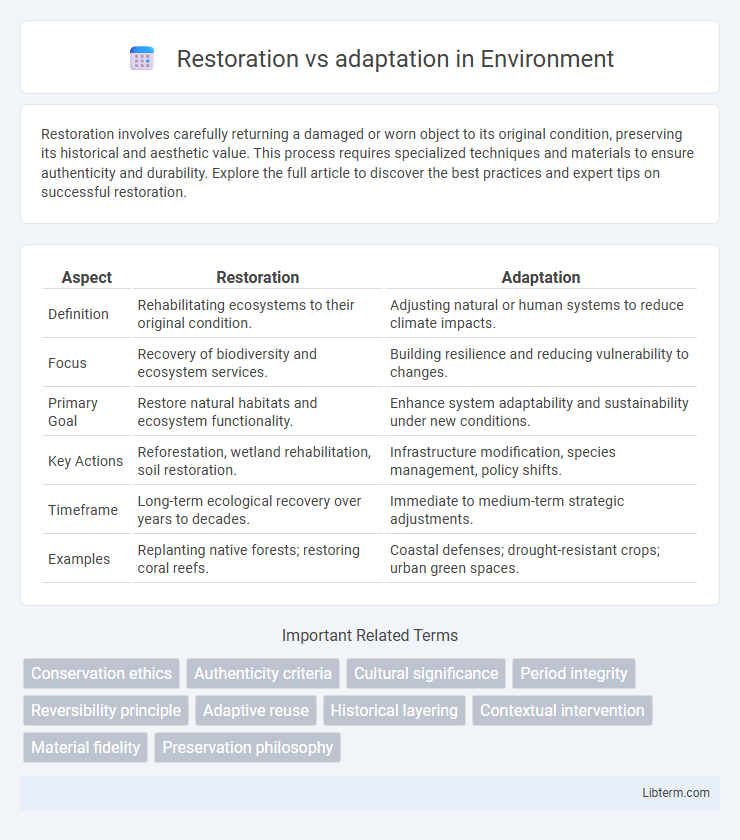Restoration involves carefully returning a damaged or worn object to its original condition, preserving its historical and aesthetic value. This process requires specialized techniques and materials to ensure authenticity and durability. Explore the full article to discover the best practices and expert tips on successful restoration.
Table of Comparison
| Aspect | Restoration | Adaptation |
|---|---|---|
| Definition | Rehabilitating ecosystems to their original condition. | Adjusting natural or human systems to reduce climate impacts. |
| Focus | Recovery of biodiversity and ecosystem services. | Building resilience and reducing vulnerability to changes. |
| Primary Goal | Restore natural habitats and ecosystem functionality. | Enhance system adaptability and sustainability under new conditions. |
| Key Actions | Reforestation, wetland rehabilitation, soil restoration. | Infrastructure modification, species management, policy shifts. |
| Timeframe | Long-term ecological recovery over years to decades. | Immediate to medium-term strategic adjustments. |
| Examples | Replanting native forests; restoring coral reefs. | Coastal defenses; drought-resistant crops; urban green spaces. |
Introduction: Understanding Restoration and Adaptation
Restoration involves returning ecosystems or landscapes to their original state by repairing damage and reestablishing native species, emphasizing historical fidelity and ecological integrity. Adaptation focuses on modifying natural or human systems to cope with changing environmental conditions, prioritizing resilience and functionality under current or future scenarios. Both approaches play critical roles in environmental management, with restoration aiming to reverse degradation and adaptation preparing ecosystems for ongoing or anticipated stresses.
Defining Restoration: Returning to Original States
Restoration emphasizes returning a structure or environment to its original state by repairing damage and preserving historical features. This process involves using materials and techniques that match the initial construction to maintain authenticity. Restoration aims to recreate the original appearance and function accurately, often guided by historical records and architectural analysis.
Defining Adaptation: Adjusting to New Realities
Adaptation involves modifying structures, systems, or behaviors to respond effectively to changing environmental, social, or economic conditions. This process emphasizes flexibility and innovation, enabling ecosystems, communities, or technologies to maintain functionality amid new challenges such as climate change or urban development. Unlike restoration, which aims to return to an original state, adaptation prioritizes resilience and sustainability by embracing current and future realities.
Key Differences Between Restoration and Adaptation
Restoration involves returning ecosystems or historical structures to their original state by repairing damage and removing invasive elements, emphasizing preservation of authenticity. Adaptation focuses on modifying systems to cope with current and future environmental or climatic changes, prioritizing resilience and functionality over original conditions. Key differences lie in restoration's goal of historical accuracy versus adaptation's proactive approach to evolving challenges.
Benefits of Environmental Restoration
Environmental restoration enhances biodiversity by reviving native ecosystems and improving habitat quality for wildlife. It promotes carbon sequestration, reducing atmospheric CO2 levels and mitigating climate change impacts. Restored ecosystems also improve water quality and soil health, supporting sustainable agriculture and reducing erosion.
Advantages of Adaptive Strategies
Adaptive strategies offer significant advantages by enabling buildings and infrastructure to respond dynamically to changing environmental conditions, reducing vulnerability to climate impacts. These strategies support sustainable development through flexible design, which extends the lifespan of assets and minimizes the need for costly, frequent repairs. By prioritizing resilience and resource efficiency, adaptive approaches enhance community preparedness and long-term economic stability.
Challenges in Restoration Approaches
Restoration approaches face challenges such as altered ecosystems, loss of native species, and climate change impacts that complicate efforts to return habitats to their original state. Limited baseline data and the presence of invasive species make it difficult to accurately restore historical conditions. Additionally, high costs and long-term monitoring requirements pose significant obstacles to successful restoration projects.
Difficulties in Adaptation Implementation
Adaptation implementation faces challenges such as limited financial resources, insufficient stakeholder engagement, and conflicting land-use priorities. Technical complexities arise from diverse ecosystem responses and uncertain climate projections, complicating decision-making processes. Institutional barriers and policy gaps often hinder coordination and timely execution of adaptive measures.
Restoration vs. Adaptation: When to Choose Each
Restoration involves returning ecosystems or structures to their original state, preserving historical integrity and biodiversity, making it ideal for areas with significant ecological or cultural value. Adaptation focuses on modifying systems to cope with current and future environmental changes, such as climate change, ensuring resilience and functionality in altered conditions. Choose restoration when historical accuracy and conservation are paramount; opt for adaptation when facing irreversible changes requiring flexible, forward-looking solutions.
Integrating Restoration and Adaptation for Resilient Solutions
Integrating restoration and adaptation strategies enhances ecosystem resilience by combining habitat recovery with climate change response, ensuring long-term sustainability. Restoration efforts rebuild natural functions and biodiversity, while adaptive measures address evolving environmental stresses such as extreme weather and rising temperatures. This synergy supports robust ecological networks, increases carbon sequestration, and strengthens community livelihoods against climate impacts.
Restoration Infographic

 libterm.com
libterm.com